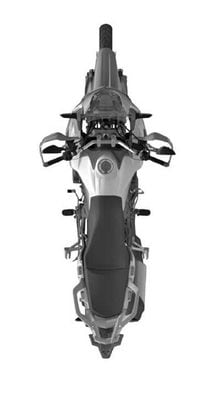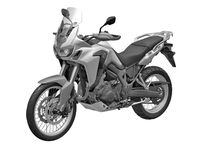Widely rumored for more than a year, the Africa Twin was previewed during 2014's bike shows in the form of Honda's True Adventure concept—a machine that was really a prototype test version of the Africa Twin (see Honda Prototypes At EICMA here). Then complete with its disguise and a carefully applied layer of mud to help hide some of the production version's details, these pictures finally reveal the bike's final appearance, albeit in black and white.
Earlier this week, Honda released the first two official pictures (darkened close-ups that give little away) but a mistimed patent filing has accidentally given away images of the final bike from every angle.
Unsurprisingly, the similarities to the True Adventure are clear to see. The frame, engine, suspension and front bodywork are all unchanged when compared to the concept bike, although the new images show a base version with a normal clutch and gear lever in place of the optional DCT set-up that featured on the True Adventure. But moving toward the stern the production version starts to differ from the concept, with a new seat and changes to the rear bodywork as well as a totally different exhaust.
These images show the muffler as a bulky, squared-off creation that incorporates the catalytic converter. That’s important, since on many modern bikes, the cat is mounted further forward on the exhaust, often under the engine. On the Africa Twin, which is intended to have real off-road ability, the pipes have been routed around the side of the engine, out of harm’s way. A fully functional bash plate, mounted securely to the frame’s bottom tube, sits where you might find a fragile catalytic converter on less serious adventure machines.
The new tail end incorporates a cast alloy grab rail and luggage rack, which is no doubt designed to mount an optional top-box. Brackets for clip-on panniers area also evident—another change compared to the True Adventure. And the seat, which was a single-piece unit on the concept bike, is now split into separate rider and passenger elements. Patents filed over the last few months reveal that this is down to a lightweight height-adjustment arrangement that the firm has devised for the Africa Twin. The rider’s section of the seat can be removed and clipped back into place at various heights, while the slanted joint between it and the pillion section means that it always precisely fits the gap between the passenger seat and the sloping back of the tank, regardless of height setting.
Technically, the biggest change compared to the True Adventure is the choice of tires, which are far more road-friendly on the bike in these pictures. No doubt riders will be offered a choice of rubber, though, and the wheel sizes—21 inches at the front and 18 inches at the rear—lend themselves to an array of proper knobby tires if you’re serious about taking your Africa Twin away from the asphalt.
Honda remains shy about the bike’s technical specifications, but once again patents leap to our aid here. The firm’s technical patents on the engine reveal that it’s a 1000cc parallel twin—hence the CRF1000L name—with four valves per cylinder, a DOHC head, and dual balancer shafts to help keep it smooth. There’s a 270-degree crankshaft, which means the firing intervals will emulate those of a 90-degree V-twin (think Yamaha Super Ténéré and FZ-07). Output is unknown but likely to be around 110 horsepower.
The chassis is all aluminum, and suggests that the bike will be among the lightest big adventure machines on the market. Honda has also gone a long way to make it feel less bulky, repositioning the airbox so it’s split into two sections and mounted outside the frame rails. By putting the two airbox sections either side of the headstock, one above each of the bike’s twin, side-mounted radiators, Honda has freed-up space for the fuel tank above the engine, in turn allowing the tank to be narrower than normal to make the bike feel less bulky.
While DCT will be optional, standard kit will include ABS. Some sort of traction control and adaptable engine settings are also likely to be part of the stock specification.
It’s confirmed that the bike will go on sale in Europe before the end of this year, with US sales coming shortly afterwards.




















/cloudfront-us-east-1.images.arcpublishing.com/octane/FZXHNOQRNVA3BIDWAF46TSX6I4.jpg)
/cloudfront-us-east-1.images.arcpublishing.com/octane/JRSFLB2645FVNOQAZCKC5LNJY4.jpg)
/cloudfront-us-east-1.images.arcpublishing.com/octane/ITNLTIU5QZARHO733XP4EBTNVE.jpg)
/cloudfront-us-east-1.images.arcpublishing.com/octane/VZZXJQ6U3FESFPZCBVXKFSUG4A.jpg)
/cloudfront-us-east-1.images.arcpublishing.com/octane/QCZEPHQAMRHZPLHTDJBIJVWL3M.jpg)
/cloudfront-us-east-1.images.arcpublishing.com/octane/HXOUJXQWA5HBHGRO3EMJIGFMVI.jpg)

/cloudfront-us-east-1.images.arcpublishing.com/octane/3TIWWRV4JBBOLDVGRYECVVTA7Y.jpg)
/cloudfront-us-east-1.images.arcpublishing.com/octane/KIX5O23D5NAIBGFXBN3327DKZU.jpg)
/cloudfront-us-east-1.images.arcpublishing.com/octane/7GJYDUIPXRGMTMQKN6ONYOLBOU.jpg)
/cloudfront-us-east-1.images.arcpublishing.com/octane/MUQLOVLL2ZDGFH25ILABNBXKTI.jpg)
/cloudfront-us-east-1.images.arcpublishing.com/octane/TNOU5DNE2BC57MFPMGN2EIDXAM.jpg)
/cloudfront-us-east-1.images.arcpublishing.com/octane/GTCXACQGJ5HAPDTGWUQKDEH44E.jpg)
/cloudfront-us-east-1.images.arcpublishing.com/octane/S35YGSEMEZB4BLTDJTSZPF4GLA.jpg)
/cloudfront-us-east-1.images.arcpublishing.com/octane/5UOT6HPX2JFMRJAX6EH45AR4MQ.jpg)
/cloudfront-us-east-1.images.arcpublishing.com/octane/OKWOJWAKP5EP3OACCRRWPCIX2Q.jpg)
/cloudfront-us-east-1.images.arcpublishing.com/octane/2WF3SCE3NFBQXLDNJM7KMXA45E.jpg)
/cloudfront-us-east-1.images.arcpublishing.com/octane/G4MG6OUCJNBSHIS2MVVOTPX65E.jpg)
/cloudfront-us-east-1.images.arcpublishing.com/octane/IIGGWFOTOJGB7DB6DGBXCCMTDY.jpg)
/cloudfront-us-east-1.images.arcpublishing.com/octane/QSTCM6AVEZA5JJBUXNIQ3DSOF4.jpg)
/cloudfront-us-east-1.images.arcpublishing.com/octane/U4I7G625B5DMLF2DVIJDFZVV6M.jpg)
/cloudfront-us-east-1.images.arcpublishing.com/octane/B6XD6LS6IVCQPIU6HXDJSM3FHY.jpg)
/cloudfront-us-east-1.images.arcpublishing.com/octane/ICL63FEDDRDTTMINYICCEYGMDA.jpg)
/cloudfront-us-east-1.images.arcpublishing.com/octane/FCGZHQXRBZFLBAPC5SDIQLVF4I.jpg)